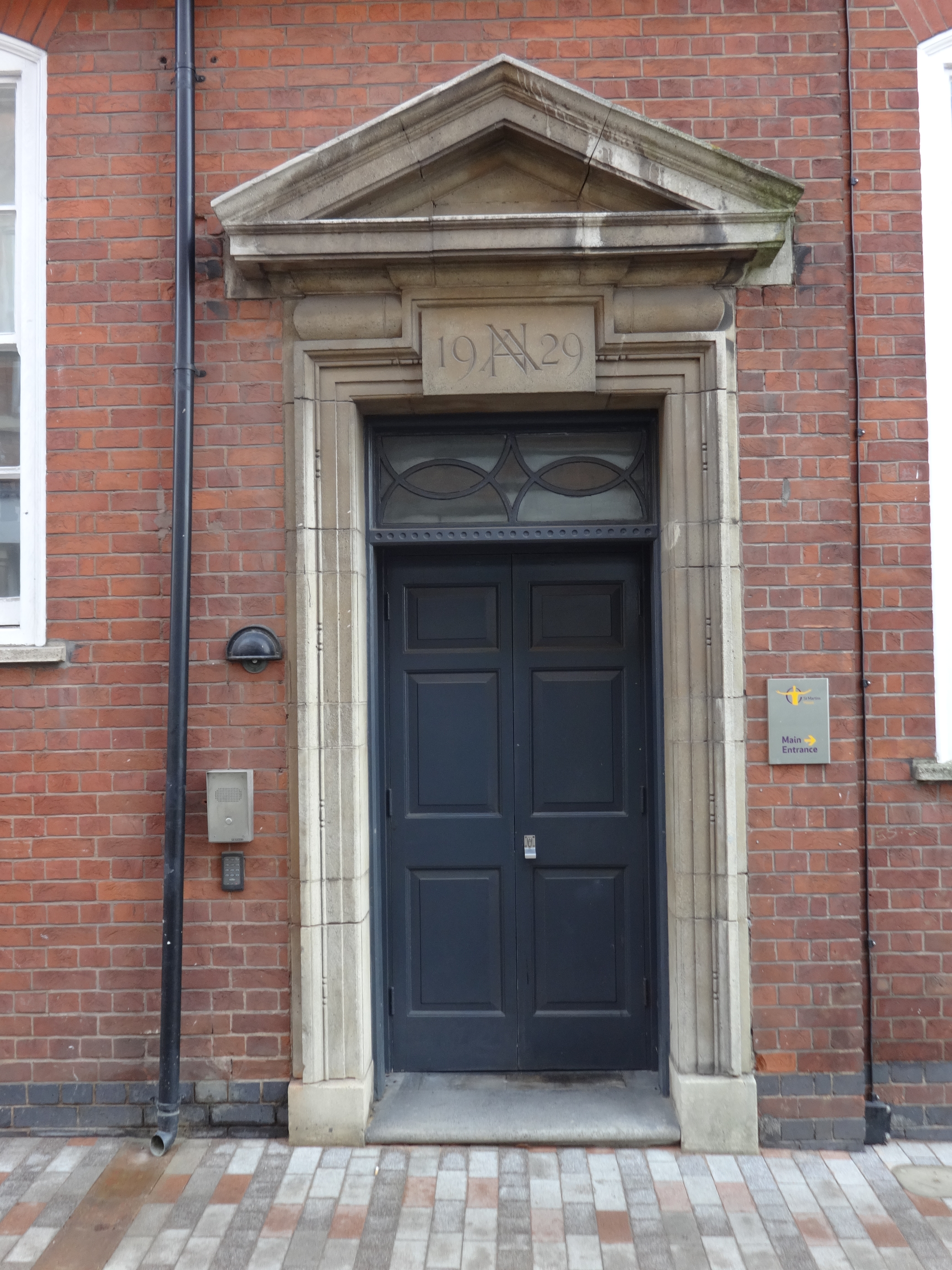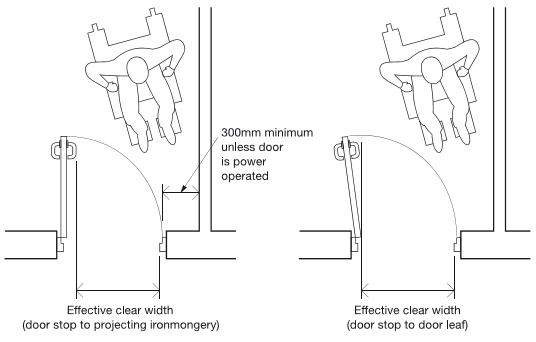Doors
Contents |
[edit] Introduction
Doors are openable barriers at the entrance to buildings, rooms or other spaces such as cupboards that allow people, vehicles or goods to enter and leave. They most commonly swing on hinges and include furniture or ironmongery that allows them to open, close, stay closed and sometimes to lock.
[edit] The history of doors
The earliest known doors were simple pieces of wood or stone that were used to cover openings in primitive dwellings. They were often small and low, primarily serving as a means of protection from the elements and animals.
In the ancient Egyptian civilization, doors became more refined and were decorated with intricate carvings and other adornments. The Egyptians also developed the pivoting door, which operated on a central pivot point and allowed for larger, more grand doorways.
The Greeks and Romans further developed door technology by introducing hinged doors, allowing for easier opening and closing. They were commonly made from wood and sometimes featured metal embellishments.
During the Middle Ages, doors became larger and more ornate. They were often made from heavy wood and featured iron hardware for added security. Castle doors, in particular, were designed to be thick and sturdy, serving as a defensive barrier against invaders.
In the Renaissance and Baroque periods, doors underwent a transformation in design and craftsmanship. Elaborate carvings, moldings, and decorative elements became more common, reflecting the artistic styles of the time. They were often made from expensive woods and were status symbols for wealthy individuals.
With the advent of the Industrial Revolution in the 18th and 19th centuries, doors began to be mass-produced. This led to increased accessibility and affordability.
In the 20th century, advances in materials and technology revolutionised door manufacturing. Steel, glass, and aluminium became popular choices, allowing for greater versatility in design and increased durability. Automatic doors and electronic access systems were developed, offering convenience and improved accessibility.
Today, doors come in a wide variety of styles, materials, and functionalities, ranging from traditional wooden doors to high-tech automatic sliding doors. They serve not only as functional barriers but also as architectural elements that contribute to the overall aesthetics of buildings.
[edit] Types of door
There are a very wide variety of door types:
- Internal / external.
- Fire rated / escape.
- Accessible.
- Integral frame / separate frame or frameless.
- Solid, transparent or translucent, either in part (such as vision panels) or in their entirety. Transparent doors may include manifestation as required by Part K of the Building Regulations.
- Manually operated or powered.
- One leaf or two leaf.
- Hinged inwards, outward or both, or revolving, rolling or sliding.
- Acoustic.
- Energy rated.
- Timber (hollow or solid core), aluminium, steel, UPVC, glass, and so on.
For more information, see Types of door.
[edit] Construction, ironmongery and other door furniture
Typically, the opening for a door is formed by a penetration through a wall, with a lintel over the opening to transfer the structural load to the side walls. The door is then secured to a door lining or casing which is then concealed behind a door surround or architrave.
In order to allow proper operation and durability, doors may include:
- Locks, bars, release mechanisms and entry systems.
- Hinges.
- Closers (although these may disadvantage people with limited upper body strength).
- Pull handles, push plates and kicker plates.
- Door stops, latches, chains and hooks.
- Vision panels and manifestation.
- Peep holes.
- Letter boxes.
- Numbers and names.
- Draught excluders.
- Intumescent strips and fire protection.
[edit] Standard sizes
Standard sizes for single leaf doors include:
| METRIC (mm) | IMPERIAL |
| 306 x 1981 | 1’ x 6’ 6” |
| 381 x 1981 | 1’3” x 6’ 6” |
| 457 x 1981 | 1’6” x 6’ 6” |
| 533 x 1981 | 1’9” x 6’ 6” |
| 610 x 1981 | 2’ x 6’ 6” |
| 686 x 1981 | 2’3” x 6’6” |
| 762 x 1981 | 2'6" x 6'6" |
| 813 x 2032 | 2'8" x 6’10” |
| 826 x 2040 | |
| 838 x 1981 | 2'9" x 6'6" |
| 864 x 1981 | 2'10" x 6'6" |
| 864 x 2083 | 2’10” x 6’10” |
| 914 x 1981 | 3' x 6'6" |
| 914 x 2134 | 3’ x 7’ |
| 926 x 2040 | |
| 1026 x 2040 | |
| 1067 x 1981 | 3’6” x 6’10” |
Custom sizes are also available.
However, the Building Regulations require a clear open width rather than a door leaf dimension. The clear open width will depend on the size of the door leaf, the width of the door leaf, the width of the frame stop, the hinge throw and the width of any door furniture on the facing side, such as the door handle.
[edit] Accessibility
Approved Document M – Access to and Use of Buildings, states that, ‘since doors are potential barriers, their use should be avoided whenever appropriate’.
In new buildings, and where practical in the refurbishment of existing buildings, doors should be designed to allow access by people with disabilities, including wheelchair users and their carers. This requires a level threshold, that suitable space is provided to allow access to and beyond doors, that doors are easy to operate, and that a minimum clear width is provided by the door opening itself.
According to Approved Document M, the effective clear width of a door ‘…is the width of the opening measured at right angles to the wall in which the door is situated from the outside of the door stop on the door closing side to any obstruction on the hinge side, whether this be projecting door opening furniture, a weather board, the door or the door stop.'
See Door clear opening width for more information.
Unless a door is powered, there must be a 300 mm clear width beyond the door on the handle side to allow wheelchair users to properly access the handle.
Doors should not exceed the maximum permissible opening force, and on manually operated doors, door furniture should be easy to operate by people with limited manual dexterity, and be readily apparent against the background of the door. To some extent, these requirements can conflict with other requirements of the buildings regulations and other regulations, for example for the provision of privacy, safety and acoustic separation.
Doors, whether open or closed, should be apparent to visually impaired people through the choice of colour and material for the door and its surroundings.
[edit] Fire doors
Appendix B of Approved document B, Fire Safety, sets out the requirements for fire doors.
It defines a fire door as:
‘A door or shutter, provided for the passage of persons, air or objects, which, together with its frame and furniture as installed in a building, is intended (when closed) to resist the passage of fire and/or gaseous products of combustion and is capable of meeting specified performance criteria to those ends. (It may have one or more leaves and the term includes a cover or other form of protection to an opening in a fire-resisting wall or floor, or in a structure surrounding a protected shaft.)’
The performance required of fire doors in different circumstances is set out in Table B1 of Appendix B of the approved document.
Article 17 of The Regulatory Reform (Fire Safety) Order 2005 requires that a maintenance regime is established to ensure equipment such as fire doors are kept in an efficient state. Article 18 requires that the responsible person appoints competent person(s) to assist in undertaking preventive and protective measures. This includes ensuring fire resisting doors and escape doors are correctly installed and maintained, with inspections carried out every 6 months.
In 2015, on their third anniversary, the FDIS reported that 61% of fire doors inspected had problems with fire or smoke seals, nearly a quarter had unsuitable hinges and many fire doors had bigger gaps between the door and frame than the required 3 mm.
[edit] Related articles on Designing Buildings
- Automatic release mechanism.
- Controlled fitting.
- Door clear opening width.
- Door closer.
- Door energy rating.
- Door restrictors.
- Door terminology.
- External doors.
- Fire compartment.
- Fire door.
- Fire Door Inspection Scheme.
- Fire resistance.
- Following edge.
- Hinge.
- How the substrate affects external timber doors.
- Ironmongery.
- Jamb.
- Leading edge.
- Mortice lock.
- Pocket door.
- Shutter.
- Smoke control door.
- Threshold.
- Types of door.
- Types of lock.
- Width of doors stairs and escape routes.
- Window.
- Window and door schedules.
Featured articles and news
RTPI leader to become new CIOB Chief Executive Officer
Dr Victoria Hills MRTPI, FICE to take over after Caroline Gumble’s departure.
Social and affordable housing, a long term plan for delivery
The “Delivering a Decade of Renewal for Social and Affordable Housing” strategy sets out future path.
A change to adoptive architecture
Effects of global weather warming on architectural detailing, material choice and human interaction.
The proposed publicly owned and backed subsidiary of Homes England, to facilitate new homes.
How big is the problem and what can we do to mitigate the effects?
Overheating guidance and tools for building designers
A number of cool guides to help with the heat.
The UK's Modern Industrial Strategy: A 10 year plan
Previous consultation criticism, current key elements and general support with some persisting reservations.
Building Safety Regulator reforms
New roles, new staff and a new fast track service pave the way for a single construction regulator.
Architectural Technologist CPDs and Communications
CIAT CPD… and how you can do it!
Cooling centres and cool spaces
Managing extreme heat in cities by directing the public to places for heat stress relief and water sources.
Winter gardens: A brief history and warm variations
Extending the season with glass in different forms and terms.
Restoring Great Yarmouth's Winter Gardens
Transforming one of the least sustainable constructions imaginable.
Construction Skills Mission Board launch sector drive
Newly formed government and industry collaboration set strategy for recruiting an additional 100,000 construction workers a year.
New Architects Code comes into effect in September 2025
ARB Architects Code of Conduct and Practice available with ongoing consultation regarding guidance.
Welsh Skills Body (Medr) launches ambitious plan
The new skills body brings together funding and regulation of tertiary education and research for the devolved nation.
Paul Gandy FCIOB announced as next CIOB President
Former Tilbury Douglas CEO takes helm.
UK Infrastructure: A 10 Year Strategy. In brief with reactions
With the National Infrastructure and Service Transformation Authority (NISTA).
























